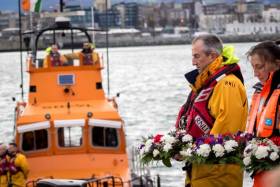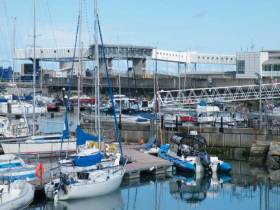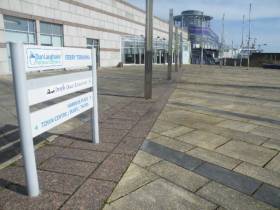Displaying items by tag: Dun Laoghaire
Dredger In Dun Laoghaire Takes Festive Season Break Due to Depart Early in the New Year
#DublinBay - A dredger docked in Dun Laoghaire Harbour just days before Christmas Day, remains in port due to space restrictions in neighbouring Dublin Port, writes Jehan Ashmore.
The hopper dredger Freeway which Afloat tracked upon arrival to Dublin Port in October, had carried out dredging works until ceasing operations for the festive season.
Freeway departed the capital and across Dublin Bay to arrive in Dun Laoghaire Harbour on 22 December, following permission sought from Dun Laoghaire Harbour to lay-up for the holiday period.
It is common prectice, Afloat adds for dredgers based in Dublin Port, to dock at the North Wall Quay Extension (next to the East-Link bridge) during dredging campaigns. The inaugural call of Irish Ferries giant newbuild cruiseferry W.B. Yeats however at 194m long has taken up a commanding presence along the North Wall.
The lack of quay space on the North Wall for the 92m Freeway is also attributed in part to the long-term berthed Shingle. The 32m vessel has lain idle since detained more than four years ago.
By coincidence, both the dredger and cruiseferry are Cypriot flagged. On related note to ferries, the North Wall is where operator P&O Ferries use berths at Terminal 3. The linkspan coupled by the frequent ferries occupy the remaining length of the North Wall.
Since the W.B. Yeats has shifted berths to the North Wall, the cruiseferry had returned to Terminal 1 to undergo further berthing including trials at a nearby linkspan. The 1,800 passenger/1,200 vehicle cruiseferry is currently back at the North Wall, though further research reveals the new ship is to shift berths on New Year's Day.
The cruiseferry is to enter service next month, initially to Holyhead and from mid-March, connecting the capital to Cherbourg, France.
As for the Freeway, it is scheduled to depart Dun Laoghaire Harbour on Wednesday. This will see the dredger return to Dublin Port to resume work.
Dun Laoghaire RNLI’s Annual Christmas Eve Ceremony Takes Place This Monday
Dun Laoghaire RNLI’s annual Christmas Eve ceremony to remember the 15 volunteer lifeboat crew who died on service in Dublin Bay on 24 December 1895 will take place at noon this coming Monday.
The short ceremony at the end of the East Pier, beside the lighthouse, will include music, readings, an ecumenical blessing and wreath-laying.
Please allow time to walk the pier to arrive for the midday start.
National Yacht Club Recruiting Senior Instructor
The National Yacht Club in Dn Laoghaire is currently seeking to recruit a senior instructor for 2019.
The successful candidate will lead the team of committed sailing instructors and coaches for the NYC’s summer courses.
Instructors will be responsible for the development of the club’s youngest members, a role that is taken extremely seriously by the club.
“Our instructors are of the highest quality in terms of professionalism, attitude, technical ability and passion for sailing,” said the club in a statement/
“We have a very active junior section with over 150 junior sailors. Potential candidates must have their Senior Instructor Certificate, or be in the process of completing the course.”
The closing date for applications is Monday 7 January. Interviews will take place in mid-January. For details on how to apply see the NYC website HERE.
Irish Coast Guard Responds To Storm-Related Incidents
Irish Coast Guard teams across Ireland have responded to incidents related to the extreme conditions brought by Storm Diana over the last two days.
Dun Laoghaire Coast Guard was tasked at lunchtime on Tuesday (27 November) to extract a member of the public that had walked out the South Bull wall during stormy conditions.
The safest option in that situation was the casualty to take shelter until the tide dropped.
Yesterday afternoon (Wednesday 28 November), the team was called out to the Shankill shoreline close to Shanganagh Water Treatment plant to reports of a vehicle submerged in water with person a trapped.
Dun Laoghaire Coast Guard were tasked immediately along with Rescue 116 from Dublin Airport and Dun Laoghaire RNLI. While crews were responding to the incident, the casualty was rescued by his colleagues. All crews were stood down.
Shortly after, Dun Laoghaire Coast Guard was tasked to another incident at the town’s East Pier, where members of the public were stranded due to waves breaching the pier wall.
On arrival, Dun Laoghaire Coast Guard members identified a few members of public on the pier and advised them to relocate to a safer location.
Elsewhere, Crosshaven Coast Guard was tasked several times, starting on Tuesday evening with a person who had fallen overboard from a yacht and had been in the water for almost an hour.
The casualty was evacuated to Crosshaven RNLI’s lifeboat station, while the coastguard crew refloated their vessel that had gone aground.
Crosshaven was tasked again yesterday morning to recover a yacht after it broke its mooring near Drakes Pool. A tow was quickly established and casualty vessel brought to safety to a Royal Cork Yacht Club mooring.
The Irish Coast Guard strongly advises the public to stay away from exposed beaches, cliffs and piers, harbour walls and promenades along the coast during storm conditions.
Remember to Stay Back, Stay High and Stay Dry.
If you see someone in difficulty in the sea, or on the shore dial 999/112 and ask for the coastguard.
Viking Marine’s Black Friday Deals Now Available
Viking Marine’s Black Friday specials are now available — but be quick as these deals only last till Monday 26 November.
Get the best savings on selected Helly Hansen bags — with up to 50% off — and get 40% off the Wave Regatta Zhik Z-Cru Jacket.
Helly Hansen washbags (black only) and Jack Wolfskin backpacks are discounted by 30%, while you can save 15% on Seago Lifelines and Marine Pool Aero lifejackets, as well as International Cruiser 250 and Precision antifouling.
 Viking Marine's eye-catching Christmas Window display on Marine Road, Dun Laoghaire
Viking Marine's eye-catching Christmas Window display on Marine Road, Dun Laoghaire
In addition, there’s 10% off binoculars, the Seago offshore lifejacket, Seago inflatable danbury, and the Harken range.
All are available online and in store, with more daily promotions on offer in store at The Pavilion on Marine Road in the heart of Dun Laoghaire.
Be sure to follow Viking Marine on Facebook, Instagram and Twitter for the latest updates.
Cruise Service Bid Competes With New Tech Hub Plans For Dun Laoghaire Ferry Terminal
Speculation that a ferry service could return to Dun Laoghaire has reached fever pitch with the news that a British company has put in a bid to operate from the St Michael’s Pier terminal.
According to The Times, the Liverpool & North Wales Steamship Company, which was restarted two years ago, envisages running regular passenger cruises in the Irish Sea and will be “ready to sail” from next summer.
The ferry company’s chief executive Steve Payne plans to present his pitch to Dun Laoghaire-Rathdown County Council — the authority that now controls the harbour — by the end of this year, laying out plans for services that could employ 240 people.
Payne revealed to Afloat.ie that as well as the cruise bid involving its 650-passenger vessel, it also wants to operate a regular ferry service serving its home base of Liverpool and also Llandudno in North Wales.
The company’s flagship heritage pleasure steamer TSMV Endeavour is presently in refit in Liverpool.
However, one of the investors involved in the recently scrapped Harbour Innovation Campus proposal says he intends to push on with a tech hub scheme for the former ferry terminal.
Ian Lucey currently faces a High Court action from Harbour Innovation Campus developer Philip Gannon in a case that’s understood to be separate from Gannon’s decision to pull out of the Dun Laoghaire venture last month.
Note: This piece has been corrected to remove a previous statement that Philip Gannon and Ian Lucey were business partners. The shareholder agreement clearly states that no partnership was created. We are happy to make this clarification.
The developer behind scrapped plans for the Harbour Innovation Campus in Dun Laoghaire is taking legal action against a tech investor, as The Sunday Times reports.
Philip Gannon filed a High Court case last Wednesday (14 November) against Ian Lucey and his firm Lucey Technology citing “specific performance”, which is often an attempt to compel a party to fulfil contractual obligations.
Neither party would comment on the case, though it is understood to be separate to Gannon’s withdrawal of his Harbour Innovation Campus plans from Dun Laoghaire last month in the absence of a foreshore licence for the earmarked St Michael’s Pier site.
Previous to that, in September, Lucey wrote in a blog post on Medium that he had moved to “step back” from the project “as [Philip Gannon’s] Blond Capital undertook more management, in line with [Lucey Fund’s] model of being a small shareholder in a number of businesses.”
The Sunday Times has more on the story HERE.
Note: This piece has been corrected to remove a previous statement that Philip Gannon and Ian Lucey were business partners. The shareholder agreement clearly states that no partnership was created. We are happy to make this clarification.
New Infrastructure Fund Could Rekindle Ambitions For Dun Laoghaire As National Watersport Hub
Ambitions for a National Watersport Centre in Dun Laoghaire could be revived following the launch of a new State fund supporting infrastructure for multi-sports projects.
Applications are now being invited for the the Large Scale Sport Infrastructure Fund, launched by Ministers Shane Ross and Brendan Griffin this week.
The scheme is initially open to applications from national governing bodies (NGBs) and local authorities (LAs) and will consist of two streams.
Stream one, which is aimed at smaller NGBs and LAs, will help fund the development of proposals to tender stage. Stream two will assist applicants to bring projects from tender stage to completion.
The scheme encourages multi-functional sports facilities that will serve more than one sport — which is in line with previous proposals to make Dun Laoghaire a national hub for sailing, kayaking, rowing and more.
Sharing between sports, NGBs and LAs is encouraged and such projects will be viewed more favourably by the fund. The scheme will also require a minimum contribution of 30% from applicants toward the cost of any works/design.
The new fund is separate and distinct from the Department of Transport, Tourism and Sport’s long-running Sports Capital Programme (SCP), which is focused on smaller capital projects where the maximum grant is €150,000.
The full terms and conditions of the Large Scale Sport Infrastructure Fund and application forms can be found HERE.
Viking Marine Recruiting Full-Time & Part-Time Sales Assistants
Viking Marine is currently looking to recruit some hard-working and experienced sailing enthusiasts to work full time and part time as sales assistants in its Dun Laoghaire store.
If you are an experienced sailor with dinghy and yachts knowledge and are looking to share your passion with others, Viking Marine would love to hear from you.
Full details of the full-time and part-time sales assistant roles can be found on the Viking Marine website or click here.
To apply for either of these jobs, please e-mail your CV to [email protected]
All Eyes On Viking Marine’s Black Friday Deals
Viking Marine in Dun Laoghaire has something special in store for this year’s Black Friday sales.
Be sure to visit next Friday 23 November for exclusive savings and major discounts on clothing, safety equipment, boat hardware and more.
And be the first to know about Viking Marine’s Black Friday deals — as well as getting inditer tips on regular discounts, exclusive offers, sailing tips and more besides — by signing up for their email newsletter.
Follow Viking Marine on Facebook, Instagram and Twitter for the latest updates.





































































